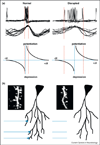Dynamical changes in neurological diseases and anesthesia
- PMID: 22446010
- PMCID: PMC3965179
- DOI: 10.1016/j.conb.2012.02.009
Dynamical changes in neurological diseases and anesthesia
Abstract
Dynamics of neuronal networks can be altered in at least two ways: by changes in connectivity, that is, the physical architecture of the network, or changes in the amplitudes and kinetics of the intrinsic and synaptic currents within and between the elements making up a network. We argue that the latter changes are often overlooked as sources of alterations in network behavior when there are also structural (connectivity) abnormalities present; indeed, they may even give rise to the structural changes observed in these states. Here we look at two clinically relevant states (Parkinson's disease and schizophrenia) and argue that non-structural changes are important in the development of abnormal dynamics within the networks known to be relevant to each disorder. We also discuss anesthesia, since it is entirely acute, thus illustrating the potent effects of changes in synaptic and intrinsic membrane currents in the absence of structural alteration. In each of these, we focus on the role of changes in GABAergic function within microcircuits, stressing literature within the last few years.
Copyright © 2012. Published by Elsevier Ltd.
Figures



References
-
- Doyle LMF, Kuhn AA, Hariz M, Kupsch A, Schneider GH, Brown P. Levodopa-induced modulation of subthalamic beta oscillations during self-paced movements in patients with Parkinson’s disease. Eur J Neurosci. 2005;21:1403–1412. - PubMed
-
- Hammond C, Bergman H, Brown P. Pathological synchronization in Parkinson’s disease: networks, models and treatments. Trends Neurosci. 2007;30:357–364. - PubMed
-
- Weinberger M, Mahant N, Hutchison WD, Lozano AM, Moro E, Hodaie M, Lang AE, Dostrovsky JO. Beta oscillatory activity in the subthalamic nucleus and its relation to dopaminergic response in Parkinson’s disease. J Neurophysiol. 2006;96:3248–3256. - PubMed
-
- Silberstein P, Pogosyan A, Kuhn AA, Hotton G, Tisch S, Kupsch A, Dowsey-Limousin P, Hariz MI, Brown P. Cortico-cortical coupling in Parkinson’s disease and its modulation by therapy. Brain. 2005;128:1277–1291. - PubMed
-
- Kühn AA, Tsui A, Aziz T, Ray N, Brücke C, Kupsch A, Schneider GH, Brown P. Pathological synchronisation in the subthalamic nucleus of patients with Parkinson’s disease relates to both bradykinesia and rigidity. Exp Neurol. 2009;215:380–387. - PubMed
Publication types
MeSH terms
Substances
Grants and funding
LinkOut - more resources
Full Text Sources
Medical

